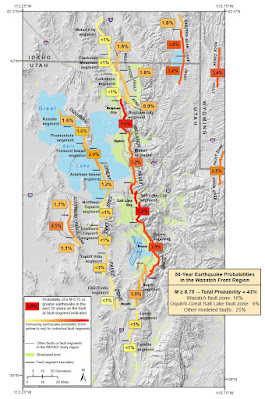Wasatch Fault Earthquake Risk
The Wasatch Fault is a normal fault, where the Wasatch range mountain block of crust slips mostly vertical, relative to the western, valley-side that has a downward movement. It is the “most studied…normal fault in the world” (Earthquake Probabilities for the Wasatch Front Region in Utah, Idaho, and Wyoming ).
The fault runs for about 240 miles and has 10 segments. The north end reaches towards Malad City, Idaho, and the southern-most segment extends to Fayette, Utah. Each segment is thought to rupture independent of the others. Because of the multiple segments, the term Wasatch Fault Zone is often used interchangeably with Wasatch Fault.
The Wasatch Fault is the most active fault of the seismically active area known as the Intermountain seismic belt, which extends from Montana south to Arizona, and west to Nevada.
Wasatch Fault - Central Segments
The five central segments of the Wasatch Fault have had at least 22 surface-faulting earthquakes during the last 6,000 years. These central segments extend from Brigham City in the north to Nephi in the south. The Wasatch Front urban corridor, which includes the cities from Ogden to Salt Lake City to Provo, are in these segments.
Individually, each central segment has its own recurrence interval ranging from 700 to 2,700 years.
Collectively, the average recurrence interval (long-term average) of these large earthquakes is about once every 300 years. That means, on average, one of these five segments has a large earthquake hit about every 300 years.
The last definitively large earthquake happened on the Provo segment about 600 years ago.
Another large earthquake hit the Levan segment, south of Nephi, about 1,300 years ago.
There are some discrepancies among sources about a large quake on the Nephi segment (just south of the Provo segment) that possibly occurred 400 years ago. Some carbon-dating indicates it struck the area about 1,200 years ago. However, research in the last few years has once again revised that estimate to about 200 to 300 years ago. If anything, this just proves how much earthquake research is changing and revising what we think we know.
The outlying, or distal, segments have recurrence intervals of about 10,000 years.
Earthquake Risk
The largest earthquake potential for any of the segments along the Wasatch Fault is estimated to be a magnitude 7.5.
Based on the limited 6,000-year earthquake record, the next Big One is past due. It’s been over 600 years since the rupture on the Provo segment, and possibly less than that since the last Nephi event. However, using the 300-year average, the area is past due for its next Big One.
Where the next Big One will strike and when it will happen is unknown. Of the five central faults, the Brigham City segment has gone longest since any major activity so it could be the most susceptible. However, if segment ruptures are fairly regular, then the Salt Lake segment is the next one to be hit.
Previous estimates put the likelihood of a large earthquake at 13 percent in the next 50 years, and 25 percent in the next 100 years. But those estimates are outdated.
The Working Group of Utah Earthquake Probabilities (WGUEP) conducted a thorough analysis of the probability of large earthquakes along the Wasatch Front area, and then produced a report in 2016. The results of the report were surprising.
The analysis factored in the various fault zones in the area. Previously, evidence of only 18 surface-rupturing quakes had been found along the central segments. Additional research identified at least 22 large earthquakes in the last 6,000 years in the segments from Brigham City to Nephi.
Another change was the estimated recurrence interval. Previously the average between large earthquakes was estimated to be about every 350 years. The new interval is every 300 years. The individual central segments have average ruptures where also changed, ranging from 700 to 2,700 years. Earlier studies had recurrence intervals ranging from 1,200 to 2,600 years. You may note the range decreased 500 years on the low end and only 100 years at the high.
The study confirmed that both the Brigham City and Salt Lake segments have gone the longest without major earthquakes, which places the highest risk of large quakes on those segments.
During the past 6,000 years, large earthquakes on the Salt Lake segment have occurred about every 1,300 years. Over a 14,000-year period, large ruptures average about every 1,500 years. The last Big One on the Salt Lake segment happened 1,400 years ago.
Combining the average intervals and when the last earthquakes happened on the various central segments of the Wasatch Fault, the greatest risk seems to be in the Salt Lake segment. When you also factor in the risks to population, structure, infrastructure, and economy, the earthquake threat in the Salt Lake area is extremely concerning.
Wasatch Fault - New Earthquake Probabilities
From recent research and analysis, new earthquake probabilities were developed.
Overall, the Wasatch Front region has a 43 percent probability of experiencing a magnitude 6.75 or larger earthquake in the next 50 years. The chances of a magnitude 6.0 or larger are 57 percent. The Wasatch Fault itself is projected to have a probability of 18 percent for large earthquakes of magnitudes 6.0 and 6.75 or larger.
It should be noted that the probabilities are for one or more earthquakes of at least these magnitudes. That means there is just as good a chance that there could be more than one Big One. So, if a Big One occurs, don’t get complacent thinking another can’t happen in your lifetime.
It should also be noted that the percentages for individual fault zones are specifically for those zones. So, if one fault zone has a major rupture, the others still have their probabilities of Big Ones.









Comments
Post a Comment